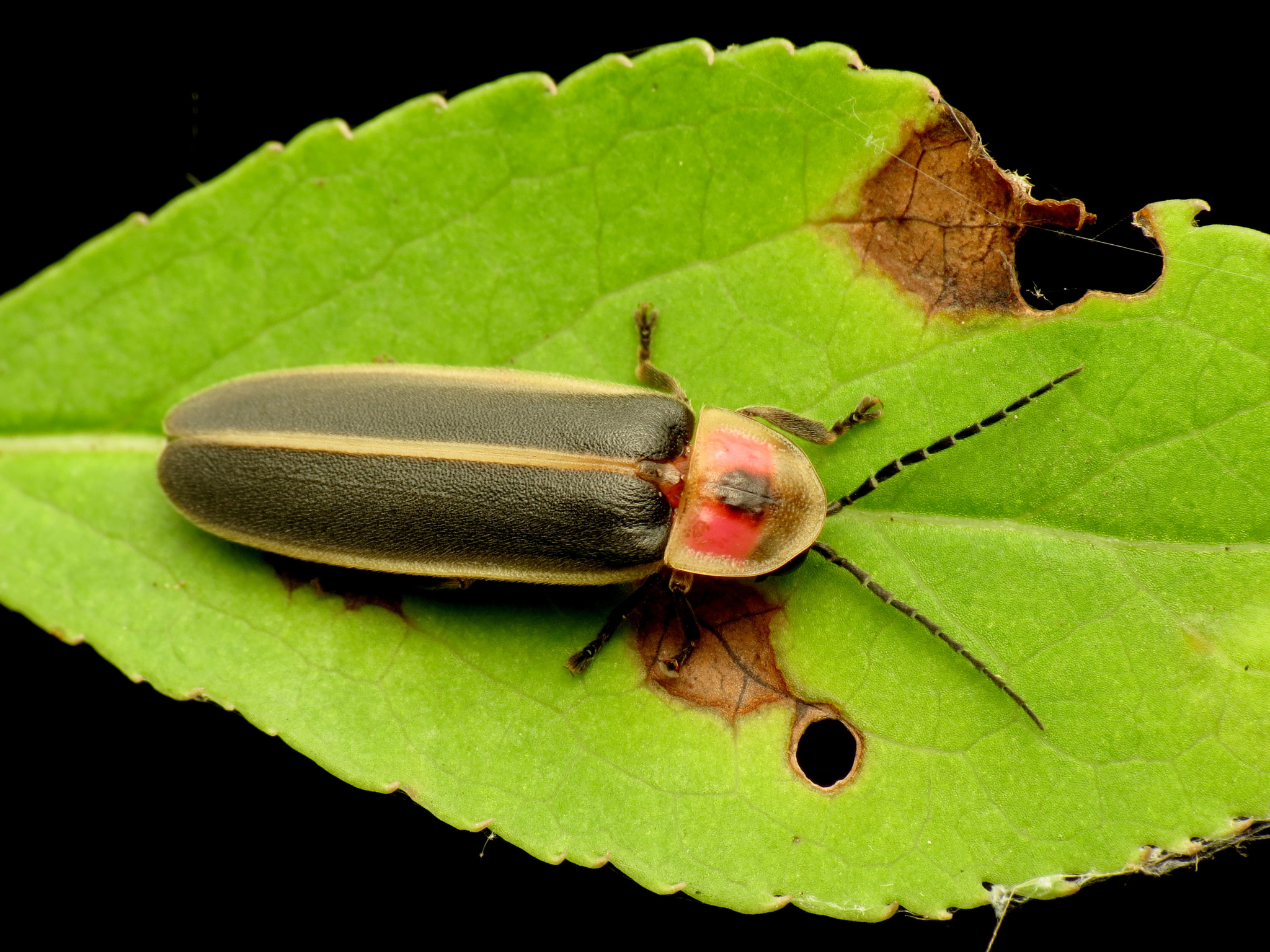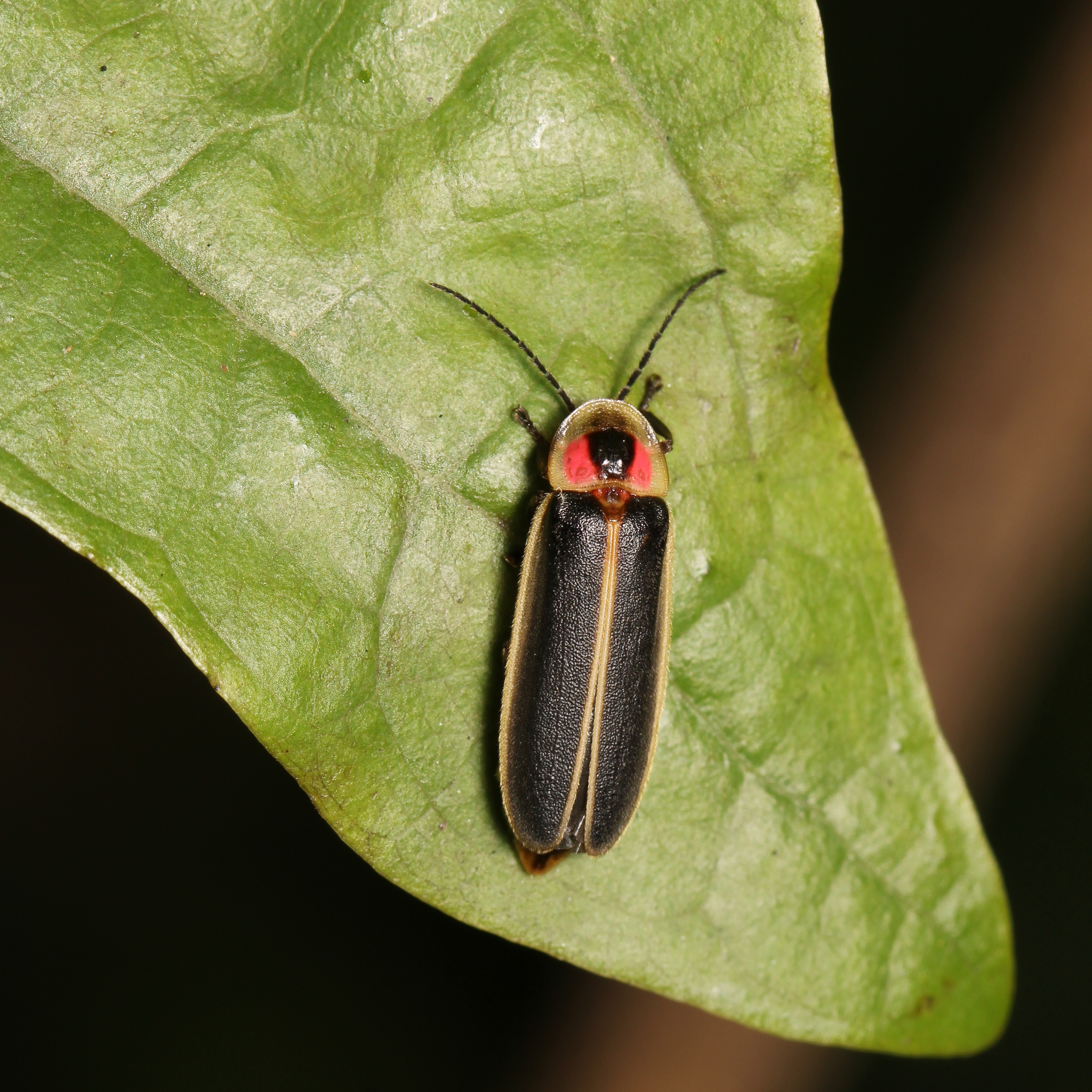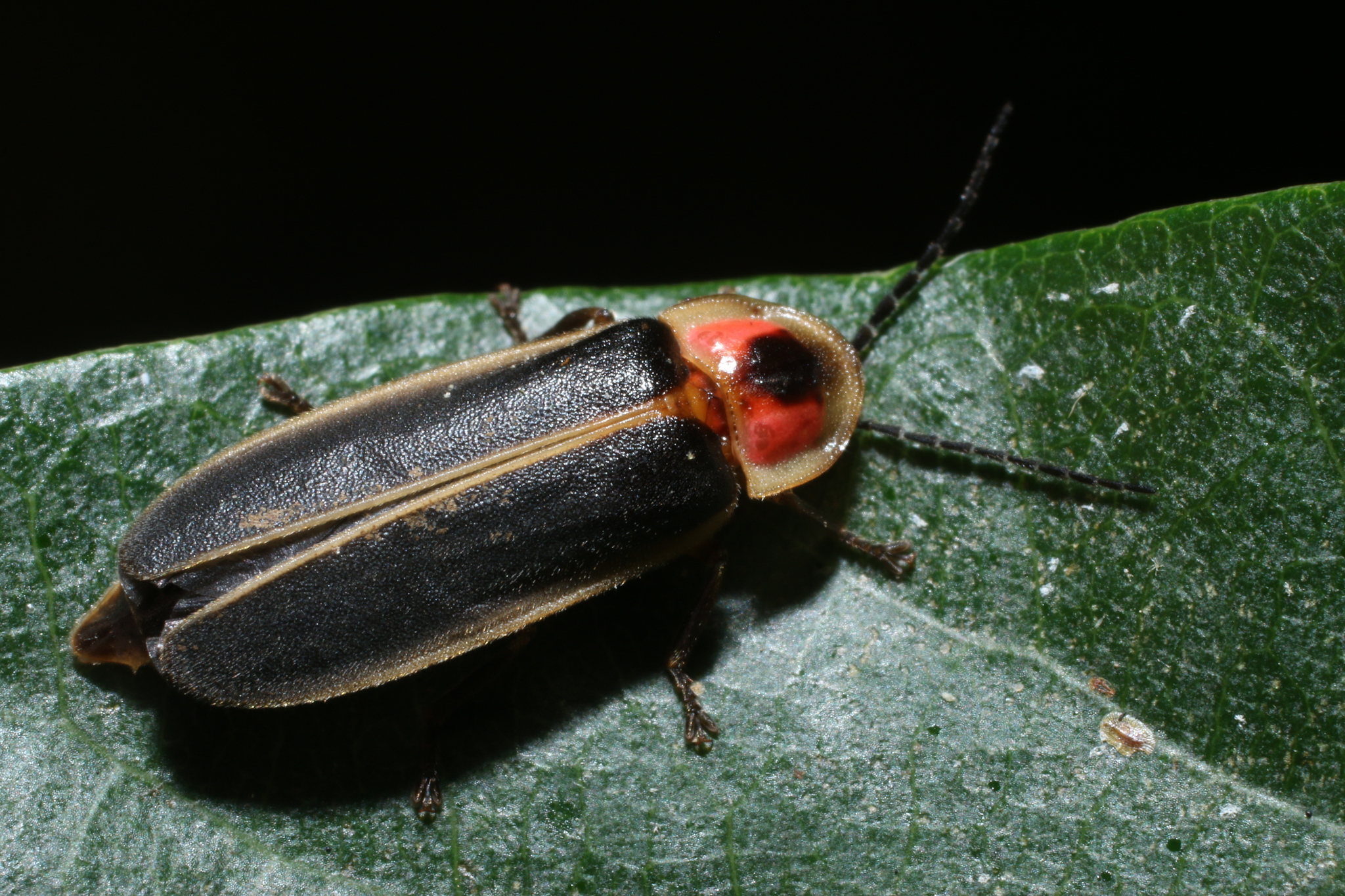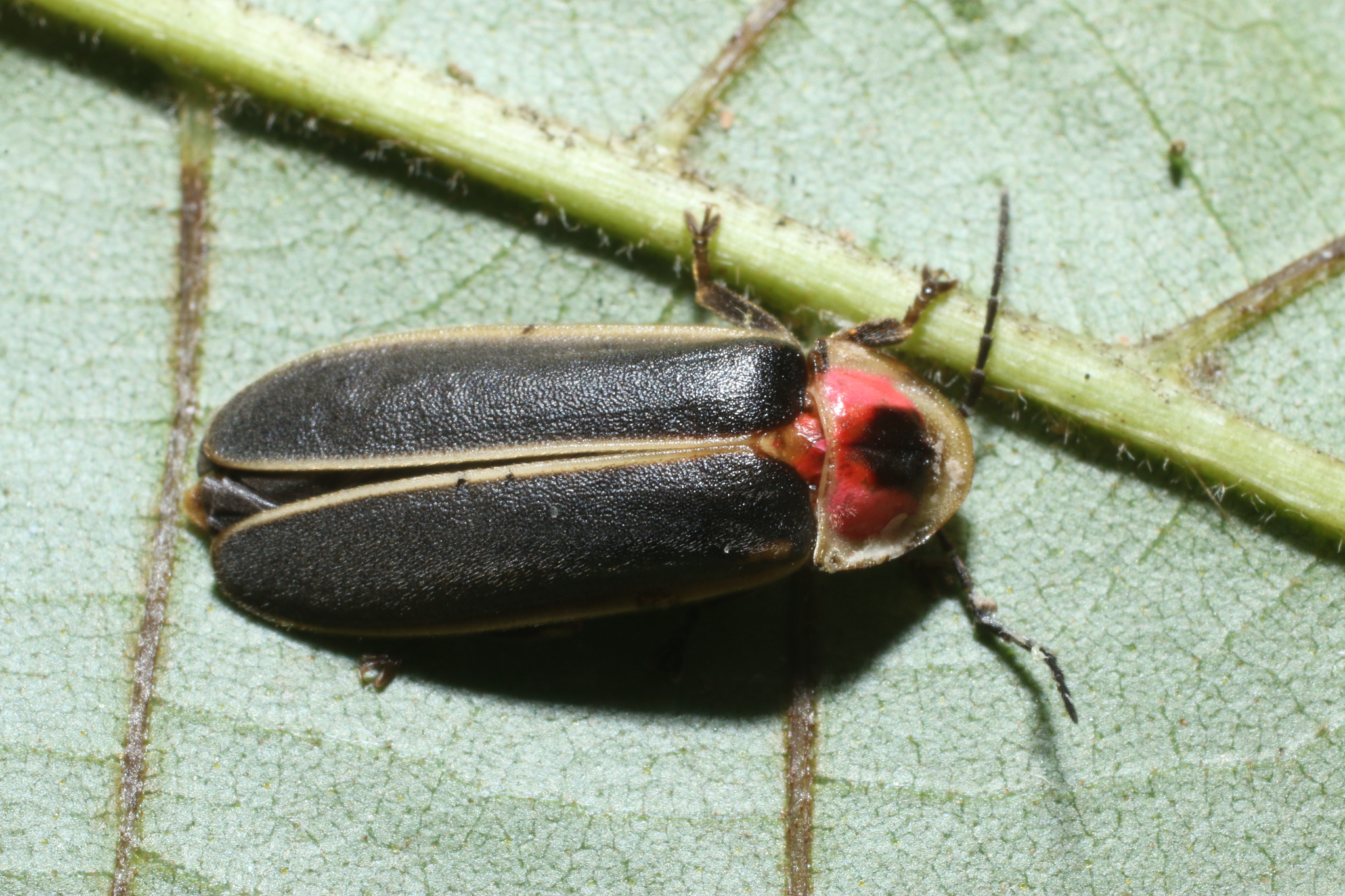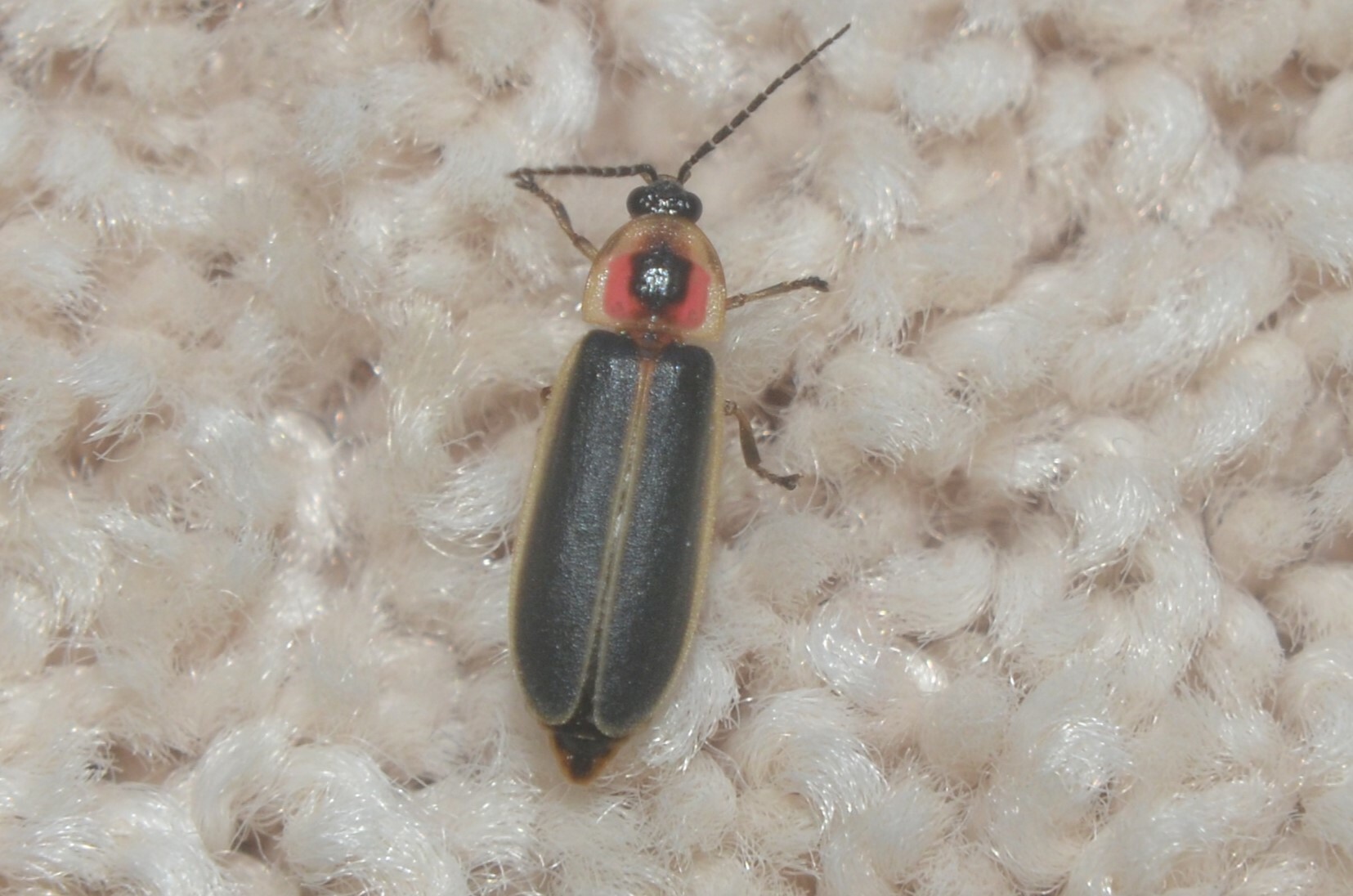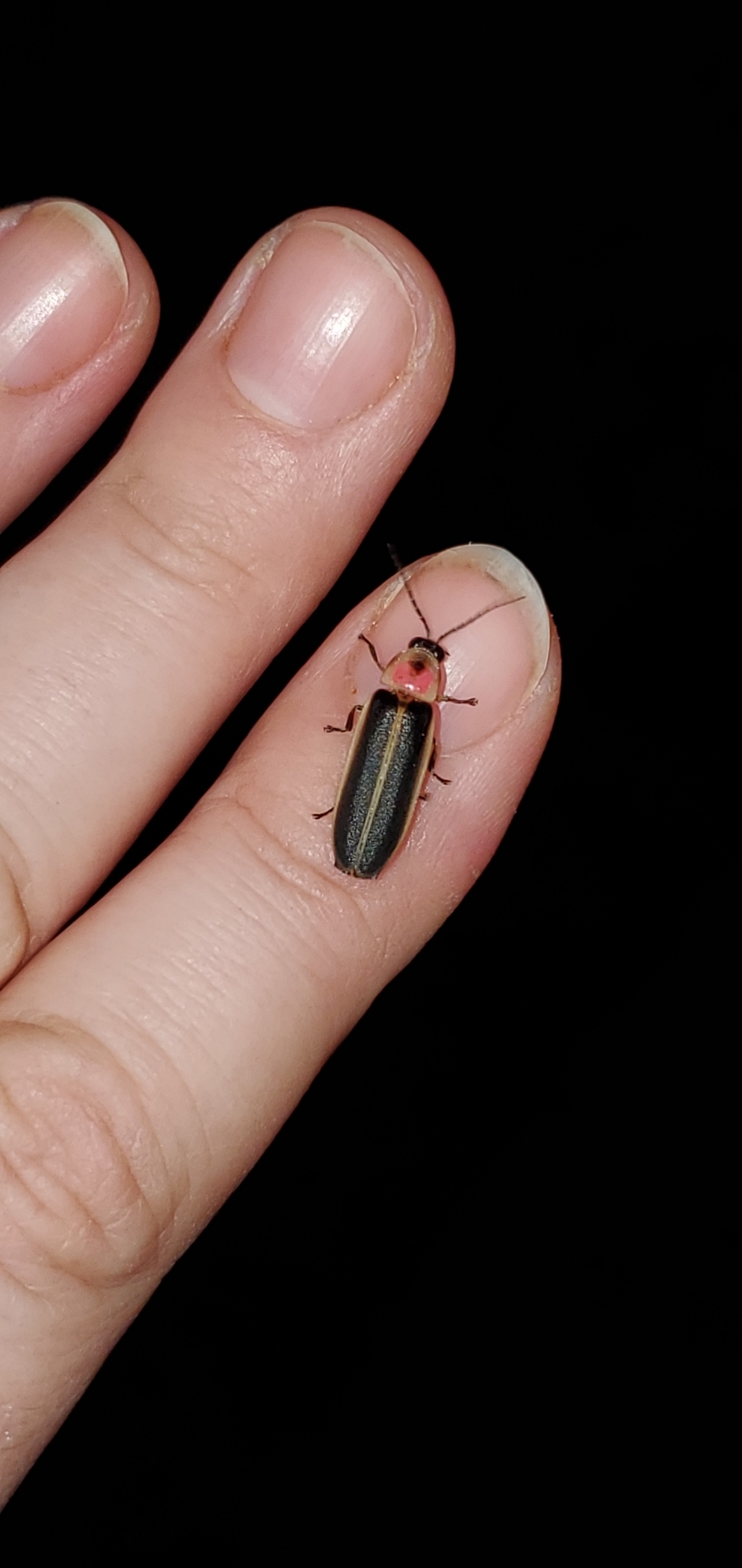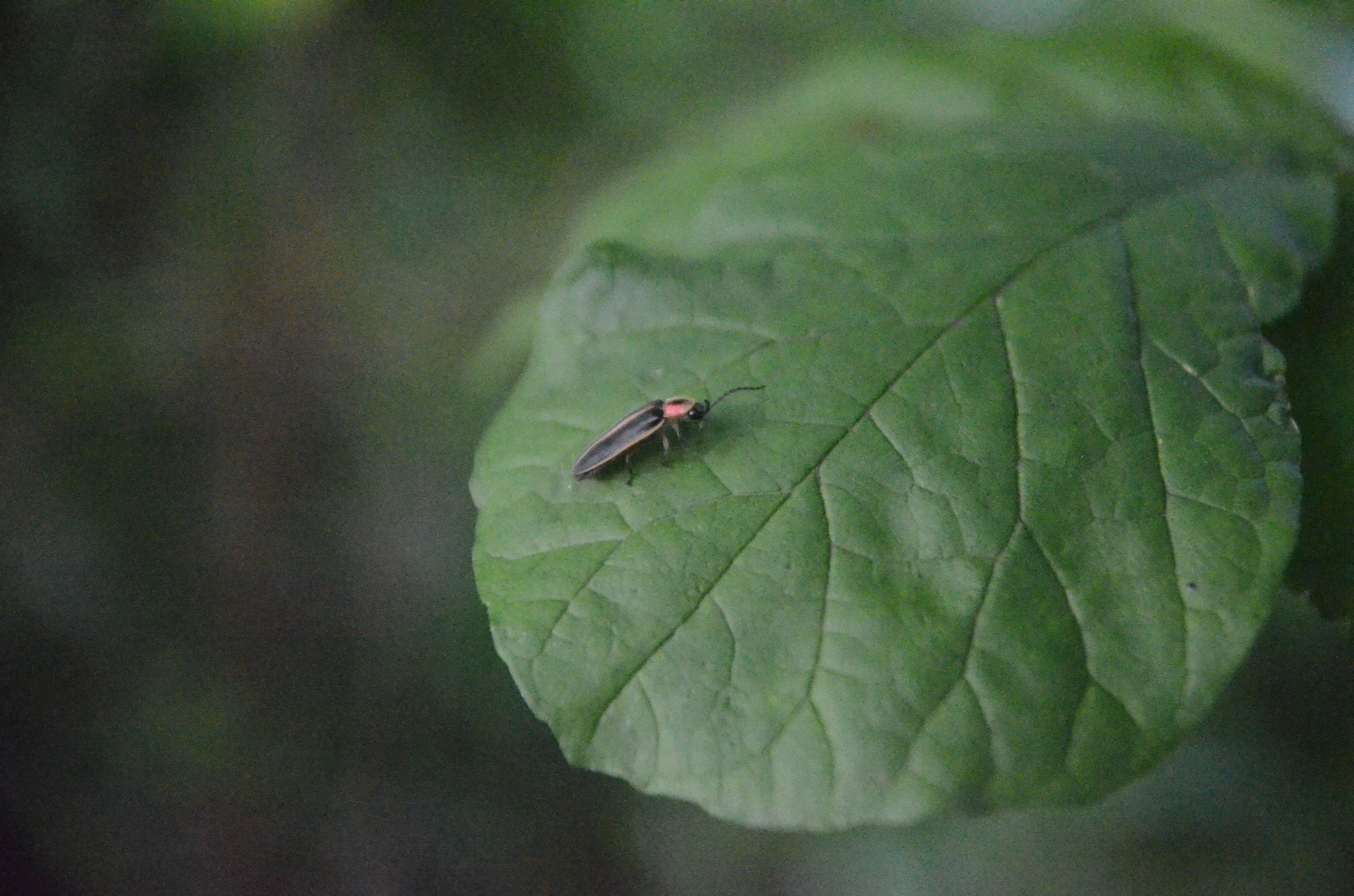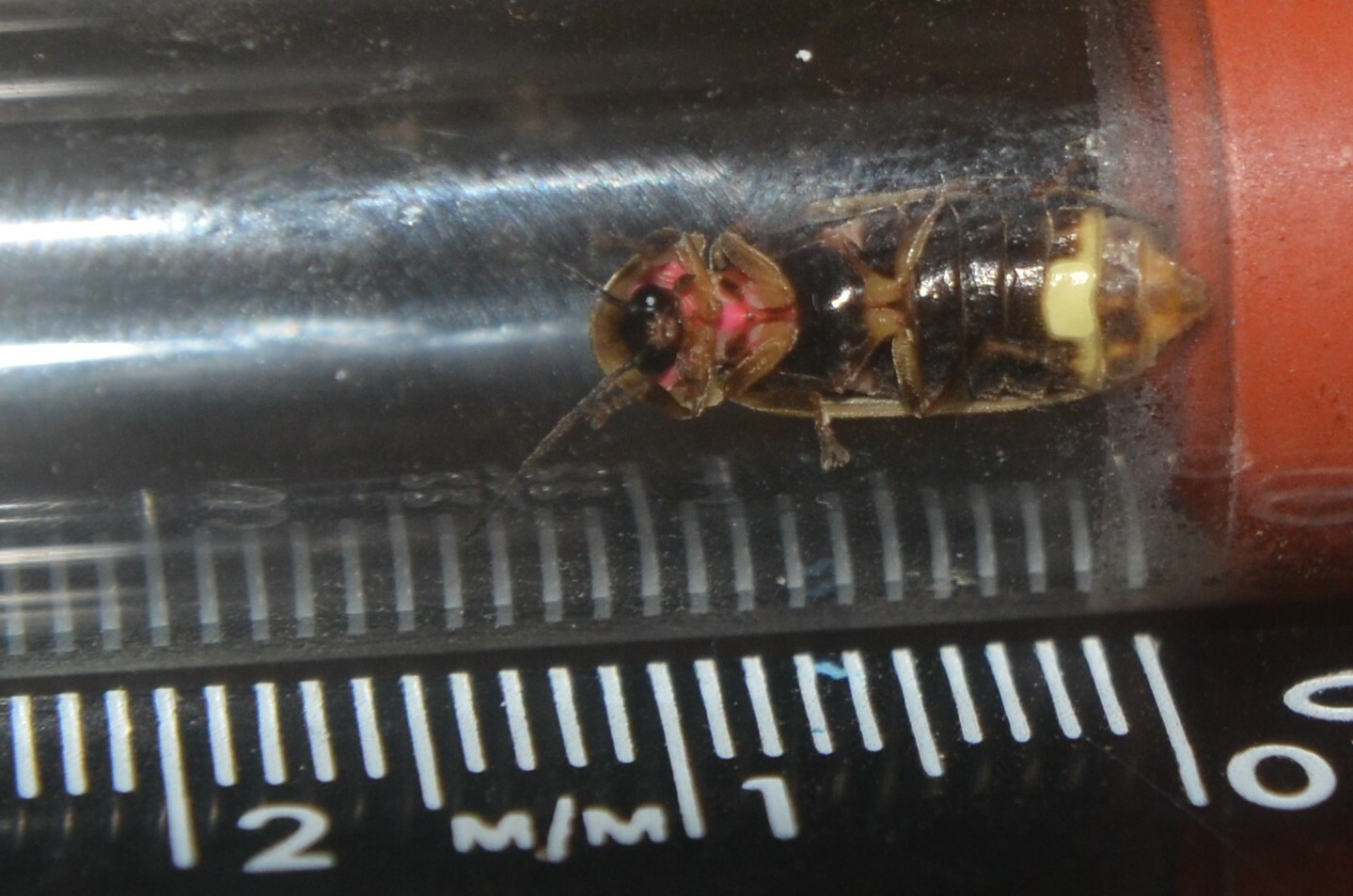Map Snapshot
















44 Records
Seasonality Snapshot
Source: Wikipedia
| Common eastern firefly | |
|---|---|

| |
| Scientific classification | |
| Domain: | Eukaryota |
| Kingdom: | Animalia |
| Phylum: | Arthropoda |
| Class: | Insecta |
| Order: | Coleoptera |
| Family: | Lampyridae |
| Tribe: | Photinini |
| Genus: | Photinus |
| Species: | P. pyralis
|
| Binomial name | |
| Photinus pyralis | |
Photinus pyralis, also known by the common names the common eastern firefly[3] or big dipper firefly,[4] and sometimes called a "lightning bug",[5] is a species of flying beetle. An organ on its abdomen is responsible for its light production.[6] It is the most common species of firefly in North America, and is typically found east of the Rocky Mountains. Photinus fireflies are often confused with fireflies of the similar-sounding genus, Photuris, which are also found in North America.
These fireflies are most noticeable around twilight in the spring and summer months.[7] The common name, big dipper firefly, is due to the characteristic flight of the males, whose trajectory appears to follow a J-shape, lighting on the upswing.[3][8] During flight, this J-pattern is used alongside light flashing to attract females, who rest on vegetation and signal back to males if interested.[9] The firefly flashes are stimulated by light-activated proteins, not rhythmic impulses as originally thought.
Description
[edit]Common Eastern fireflies are small soft-bodied beetles that are 9–19 mm (0.4–0.7 in) long. They have flat black or brown bodies with wing coverings, or elytra, that extend the length of their entire thorax and abdomen. The elytra have a yellow border. The head shield, or pronotum, is pale yellow, with a black dot in the center, surrounded by pink or red.[4]
Both males and females of this species have light-emitting organs on the ventral side of their abdomens. While this organ extends the length of the last three segments of the males' abdomens, it appears only in the second to last segment of the females' abdomens.[10]
Like most flying firefly species, Photinus pyralis is nocturnal.[11]
Geographic range
[edit]P. pyralis is widespread across the eastern half of North America.[1]
Habitat
[edit]
Common Eastern fireflies are found in a variety of habitats, ranging from temperate to tropical environments.[12] Some natural habitats of these fireflies include meadows, fields, wetlands, desert canyons, and dense forests, and while they can successfully thrive in all of these areas, they require moisture to survive at all life stages. They are especially drawn to areas with damp soil and long grasses to better conceal females and offspring.[4]
Home range and territoriality
[edit]Population studies have been done to investigate whether P. pyralis has always been endemic to the northeast regions of North America, especially because the species continues to occupy a wide variety of habitats across the continent. It has been discovered that ancestrally, the North American population originated in Texas during the Miocene epoch before migrating to the central states of the US and more recently, the Northeast coast. Through the tracking of single nucleotide polymorphisms (SNPs) along with other genetic markers, researchers have concluded that the common Eastern firefly possibly migrated during interglacial periods, which researchers suggest could account for the divergence to other Photinus species.[12]
Life cycle
[edit]Like all beetles, the life cycle of a common Eastern firefly consists of four unique life stages starting with the egg, moving to the larval stage, followed by a pupa, before finally completing the cycle as a fully formed adult.
The time it takes for fireflies to complete all four stages can vary drastically by species, especially because they inhabit such a wide range of environments that the resources available to them vary significantly. However, all fireflies will spend most of their time in their feeding stage as larvae. P. pyralis sometimes takes as long as two years before it pupates. As a larva, P. pyralis lives under the soil and eats worms, slugs, and snails. As it grows, it will experience multiple instars, or molting periods.[4] Because fireflies are very vulnerable during the larval stage, they have evolved to produce light as an aposematic signaling mechanism to drive away predators, regardless of whether or not they continue to be chemiluminescent in adulthood like the common Eastern firefly.[4][13]
At the end of the larval stage, P. pyralis will become a pupa. In 1 to 3 weeks, it will eclose, or emerge as an adult. The common Eastern firefly will live for approximately another three weeks to two months, during which time it will use its light to attract a mate.[4]
Risks
[edit]Although their conservation status is classified as "Least Concern" by the IUCN Red List, these fireflies do face some dangers. The biggest threats to their populations include light pollution, pesticide use, climate change, and human building and development in their habitats.[14]
Defense
[edit]Photinus pyralis contain steroid compounds called lucibufagins, which make them taste bad to potential predators, such as birds, bats, and other insects. However, some species of Photuris fireflies lack lucibufigins, and they prey on P. pyralis males in order to acquire the steroids for themselves. Although the lucibufagins are a defense mechanism for the most part, they can also serve as an attractant to some predators.[14][15] Beetles from the family Lampyridae have been known to use certain defenses such as unpleasant odour and the excretion of a sticky substance to avoid predation.[16] Excretion of unpleasant fluids containing lucibufagins from the areas along the elytra and pronotum is the result of tactile stimulation and has been referred to as reflexive bleeding.[17][18] This reflex bleeding is a defensive function of P. pyralis, as it can cause certain predators, such as ants, to become entangled in the sticky substance, or it can cause revulsion in others upon predation.[17] Whereas adult flashing is used in mate signaling, pupae glow is thought to be an aposematic display for nocturnal predators.[19]
Mating
[edit]Mate searching behavior
[edit]Males are the first to start the series of patrolling flashes needed to locate and mate with a female. Males will actively fly while flashing, whereas females are sedentary.[20] Male P. pyralis will flash every 5 to 7 seconds and wait for a responding flash from the female, which comes after a 1 to 2 second delay.[21] The length of time between male flashes is temperature dependent, with shorter intervals as temperature increases.[4] It has been shown that females only respond to their conspecific males, identifying them by the color of their yellow bioluminescent flash, in combination with the temporal patterning, duration and intensity of the male flash.[22] Females will twist their abdomen towards the male's flash, presenting their own flash toward the male. Males can be observed flying in a nearly vertical orientation, their antennae held forward and stiff while their legs are held toward the body during patrolling.[21] They also show an obvious gaze shift towards the last female flash and continue towards it until the female firefly flashes again.[21] The flashes continue until the male reaches the female. Males congregate in large masses and it is likely that more than one will find the same female; in this case male P. pyralis display aggression towards one another while not in flight.[23]
Male/male interactions and sexual selection
[edit]During the "aggression" stage, males with smaller elytra and smaller lanterns are favored, whereas during the signaling phase, males with longer elytra and bigger lanterns are favored.[23] Males with larger lanterns are favored in signaling phases of courtship because their broadcasting flashes can be seen by females who are further away. It is also suggested that due to their longer elytra these males may also have an advantage of finding the females faster.[24]
Female/male interactions and sexual selection
[edit]Among fireflies of the genus Photinus, males will first attract a female's attention with their light flashing patterns, but once they reach the females they will be selected based on the size and quality of the "nuptial gifts" they can offer. These nuptial gifts, also known as spermatophores, are a combination of sperm and high levels of protein, hormones, defensive compounds, and other nutrients which the females will subsequently use to feed the eggs should she choose to mate with the male.[25] During the adult stage of their lives, most Photinus fireflies do not eat, so all activity is fueled by energy that is consumed and subsequently stored during the larval stage; this becomes especially important regarding reproductive activity. Consequently, these nuptial gifts are a big factor in determining which male fireflies females choose to mate with. Although it ends up being a high cost to males, those with larger spermatophores tend to see increased reproductive success because they are able to provide females with more nutrients to sustain future offspring.[26] It was found that females were more likely to mate with virgin males who had never mated because their nuptial gift sizes were larger in comparison to males who had mated the previous night.[27]
Polyandry
[edit]The female common Eastern firefly is polyandrous, meaning it will mate with multiple males over multiple nights, although it will only mate with a single male in one night. This practice has been shown to increase female fecundity as well as overall lifespan.[26]


Light production
[edit]The light organ of P. pyralis is composed of two layers: a layer of refractile cells on the dorsal side and a photic layer with light-producing cells on the ventral side.[28] The light organ (specifically the photogenic layer) is supplied with numerous tracheal branches, which are thought to provide the required oxygen for light production.[28] The light-producing enzyme is luciferase, and is found within cells of the lantern.[29] Luciferase requires oxygen, luciferin and adenosine triphosphate (ATP) to catalyze a chemical reaction that produces bioluminescence in these insects.[30] It has been shown that the glow is not controlled by the tracheal end cells (which were thought to contain valves) nor by central nerve impulses through studies involving low oxygen conditions.[31] Pupae of these beetles have different light organs than the adult. They do not have the characteristic tracheal end cells of the flashing adults, and whereas the adults emit bright flashes, pupae emit low intensity glowing.[31]
Biotechnology research
[edit]Much research has been done to both figure out the mechanism by which fireflies can emit light as well as how that tool can be used advantageously in biotechnological contexts. Luciferase has become a tool for many different research strategies. In 2018 the Photinus pyralis genome sequence was published.[32]
The first use of luciferase was as a reporting marker in many high throughput assays. Because it is known that luciferase is activated by oxygen, luciferin, and ATP, the assays were specifically pertaining to reduction-oxidation reactions that occurred in various organisms.[29] It is a highly sensitive marker and is very easy and efficient to use, so it is very widely used among scientists. Recent studies have shown that the luciferase protein has been found specifically in peroxisomes of many eukaryotes, the organelles[33] responsible for carrying out oxidative reactions and producing hydrogen peroxide as a byproduct that is quickly removed. More research is being done about how this information can be used for further advancement in the field of molecular and cell biology.[34]
References
[edit]- ^ a b Walker A (2021). Photinus pyralis. The IUCN Red List of Threatened Species 2021: e.T164046430A166771623 (Report). The IUCN Red List of Threatened Species. doi:10.2305/IUCN.UK.2021-1.RLTS.T164046430A166771623.en. Archived from the original on January 19, 2024. Retrieved March 1, 2024.
- ^ "Photinus pyralis". Integrated Taxonomic Information System.
- ^ a b "Animal Pictures Archive". Archived from the original on July 17, 2011. Retrieved January 12, 2009.
- ^ a b c d e f g Faust, Lynn Frierson (2017). Fireflies, Glow-worms, and Lightning Bugs. University of Georgia Press. ISBN 978-0-8203-4872-8.
- ^ Feinstein, Julie (2011). Field Guide to Urban Wildlife. Stackpole Books. ISBN 978-0-8117-0585-1. Retrieved March 1, 2024.
- ^ Roger Segelken Lured and liquidated, gullible male fireflies supply 'femmes fatales' with a lifesaving chemical Archived June 1, 2012, at the Wayback Machine Cornell Chronicle September 1, 1997. Retrieved November 22, 2012.
- ^ Mast, S.O. 1912. Behaviour of fire-flies (Photinus pyralis) with special references to the problem of orientation. 256-272
- ^ Rau, P (1932). "Rhythmic periodicity and synchronous flashing in the firefly, Photinus pyralis, with notes on Photurus pennsylvacicus". Ecological Society of America. 13 (1): 7–11. Bibcode:1932Ecol...13....7R. doi:10.2307/1932487. JSTOR 1932487.
- ^ Maloney, Brenna; Smallwood, James (July 10, 2009). "How These Beetles Create Light". The Washington Post. Archived from the original on November 8, 2012. Retrieved July 19, 2009.
- ^ Lewis, Sara M; Wong, Choong Hay; Owens, Avalon C S; Fallon, Candace; Jepsen, Sarina; Thancharoen, Anchana; Wu, Chiahsiung; De Cock, Raphael; Novák, Martin; López-Palafox, Tania; Khoo, Veronica; Reed, J Michael (May 1, 2020). "Corrigendum: A Global Perspective on Firefly Extinction Threats". BioScience. 70 (5): 440. doi:10.1093/biosci/biaa026. ISSN 0006-3568.
- ^ "Firefly | Luminescent, Nocturnal, Bioluminescence | Britannica". www.britannica.com. February 20, 2024. Retrieved March 1, 2024.
- ^ a b Catalan, Ana; Höhna, Sebastian; Lower, Sarah E.; Duchen, Pablo (2022). "Inferring the demographic history of the North American firefly Photinus pyralis". Journal of Evolutionary Biology. 35 (11): 1488–1499. doi:10.1111/jeb.14094. ISSN 1010-061X. PMID 36168726.
- ^ "National Wildlife Federation field guide to insects and spiders & related species of North America". Choice Reviews Online. 45 (3): 45–1461-45-1461. November 1, 2007. doi:10.5860/choice.45-1461. ISSN 0009-4978.
- ^ a b IUCN (September 10, 2020). Photinus pyralis: Walker, A.: The IUCN Red List of Threatened Species 2021: e.T164046430A166771623 (Report). International Union for Conservation of Nature. doi:10.2305/iucn.uk.2021-1.rlts.t164046430a166771623.en. Archived from the original on January 19, 2024. Retrieved March 1, 2024.
- ^ Eisner, T. (1997). "Firefly "femmes fatales" acquire defensive steroids (lucibufagins) from their firefly prey". Proc. Natl. Acad. Sci. 94 (18): 9723–9728. Bibcode:1997PNAS...94.9723E. doi:10.1073/pnas.94.18.9723. PMC 23257. PMID 9275191.
- ^ Williams, F.X. (1917). "Notes on the life-history of some North American Lampryridae". Journal of the New York Entomology Society. 25: 11–33.
- ^ a b Blum, M.; Sannasi, A. (1973). "Reflex bleeding in the lampyrid Photinus pyralis: defensive function". Journal of Insect Physiology. 20 (3): 451–660. doi:10.1016/0022-1910(74)90153-x.
- ^ Meinwald, J.; Wiemer, D.F.; Eisner, T. (1979). "Lucibufagins. 2. Esters of 12-Oxo-2p,5p, 1 1 a-trihydroxybufalin, the major defensive steroids of the Firefly Photinus pyralis (Coleoptera: Lampyridae)". Journal of the American Chemical Society. 101 (11): 3055–3060. doi:10.1021/ja00505a037.
- ^ Underwood, T.J.; Tallamy, D.W.; Pesek, J.D. (1997). "Bioluminescebce in firefly larvae: a test of the aposematic display hypothesis (Coleoptera: Lampyridae)". Journal of Insect Behavior. 10 (3): 365–370. Bibcode:1997JIBeh..10..365U. doi:10.1007/bf02765604. S2CID 27224813.
- ^ Lloyd, J.E. 1966. Studies on the flash communication system in Photinus fireflies. Museum of Zoology, University of Michigan, Ann Arbor
- ^ a b c Case, J.F. (2004). "Flight studies on photic communication by the firefly Photinus pyralis". Integrative and Comparative Biology. 44 (3): 250–258. doi:10.1093/icb/44.3.250. PMID 21676704.
- ^ Lall, A.B; Worthy, K.M. (2000). "Action spectra of the female's response in the firefly Photinus pyralis (Coleoptera: Lampyridae): evidence for an achromatic detection of the bioluminescent optical signal". Journal of Insect Physiology. 46 (6): 965–968. Bibcode:2000JInsP..46..965L. doi:10.1016/s0022-1910(99)00206-1. PMID 10802109.
- ^ a b Vencl, F.V. (2004). "Allometry and proximate mechanisms of sexual selection in Photinus fireflies, and some other beetles". Integrative and Comparative Biology. 44 (3): 242–249. doi:10.1093/icb/44.3.242. PMID 21676703.
- ^ Vencl, F.V.; Carlson, D. (1998). "Proximate mechanisms of sexual selection in the firefly Photinus pryalis (Coleoptera: Lampyridae)". Journal of Insect Behavior. 11 (2): 191–207. doi:10.1023/A:1021091806472. S2CID 37790195.
- ^ Lewis, Sara M.; Cratsley, Christopher K. (January 1, 2008). "Flash Signal Evolution, Mate Choice, and Predation in Fireflies". Annual Review of Entomology. 53 (1): 293–321. doi:10.1146/annurev.ento.53.103106.093346. ISSN 0066-4170. PMID 17877452.
- ^ a b Al-Wathiqui, Nooria; Fallon, Timothy R.; South, Adam; Weng, Jing-Ke; Lewis, Sara M. (December 22, 2016). "Molecular characterization of firefly nuptial gifts: a multi-omics approach sheds light on postcopulatory sexual selection". Scientific Reports. 6 (1): 38556. Bibcode:2016NatSR...638556A. doi:10.1038/srep38556. ISSN 2045-2322. PMC 5177949. PMID 28004739.
- ^ South, A; Lewis, S.M. (April 25, 2012). "Determinants of reproductive success across sequential episodes of sexual selection in a firefly". Proceedings of the Royal Society B: Biological Sciences. 279 (1741): 3201–3208. doi:10.1098/rspb.2012.0370. PMC 3385720. PMID 22535779.
- ^ a b Beams, H.W. and Anderson, E. 1955. Light and electron microscope studies on the light organ of the firefly (Photinus pyralis). The Biological Bulletin, 375-393
- ^ a b Keller, G.A.; Gould, S.; Deluca, M.; Subramani, S. (1987). "Firefly luciferase is targeted to peroxisomes in mammalian cells". Proceedings of the National Academy of Sciences. 84 (10): 3264–3268. Bibcode:1987PNAS...84.3264K. doi:10.1073/pnas.84.10.3264. PMC 304849. PMID 3554235.
- ^ Branchini, Bruce R. (August 2, 2013). Lee, John; Smith, Kendric C. (eds.). "Chemistry of Firefly Bioluminescence". Photobiological Sciences Online. American Society for Photobiology. Retrieved March 22, 2024.
- ^ a b Hastings, J.W. and Buck, J. 1965. The firefly pseudoflash in relation to photogenic control. The Biological Bulletin, 101-113
- ^ Fallon, Timothy R; Lower, Sarah E; Chang, Ching-Ho; Bessho-Uehara, Manabu; Martin, Gavin J; Bewick, Adam J; Behringer, Megan; Debat, Humberto J; Wong, Isaac; Day, John C; Suvorov, Anton; Silva, Christian J; Stanger-Hall, Kathrin F; Hall, David W; Schmitz, Robert J (October 16, 2018). "Firefly genomes illuminate parallel origins of bioluminescence in beetles". eLife. 7. doi:10.7554/eLife.36495. ISSN 2050-084X. PMC 6191289. PMID 30324905.
- ^ "Glossary". Molecular Biology of the Cell. 4th edition. Garland Science. 2002.
- ^ Gould, Stephen J.; Subramani, Suresh (November 29, 2004). "Firefly Luciferase as a Tool in Molecular and Cell Biology". Analytical Biochemistry. 175 (1): 5–13. doi:10.1016/0003-2697(88)90353-3. PMID 3072883 – via National Library of Medicine.
External links
[edit]- BugGuide with details of Photinus pyralis
